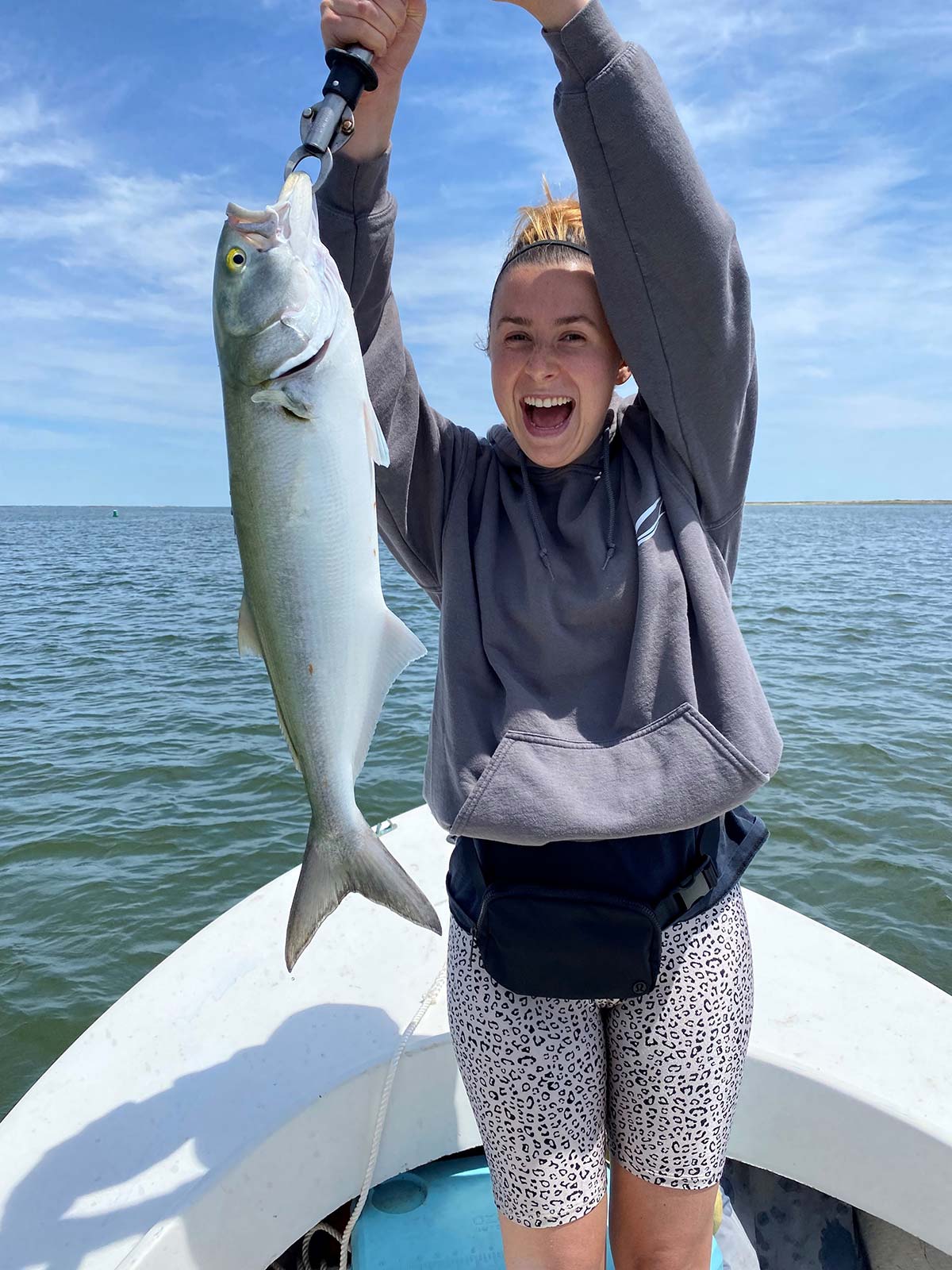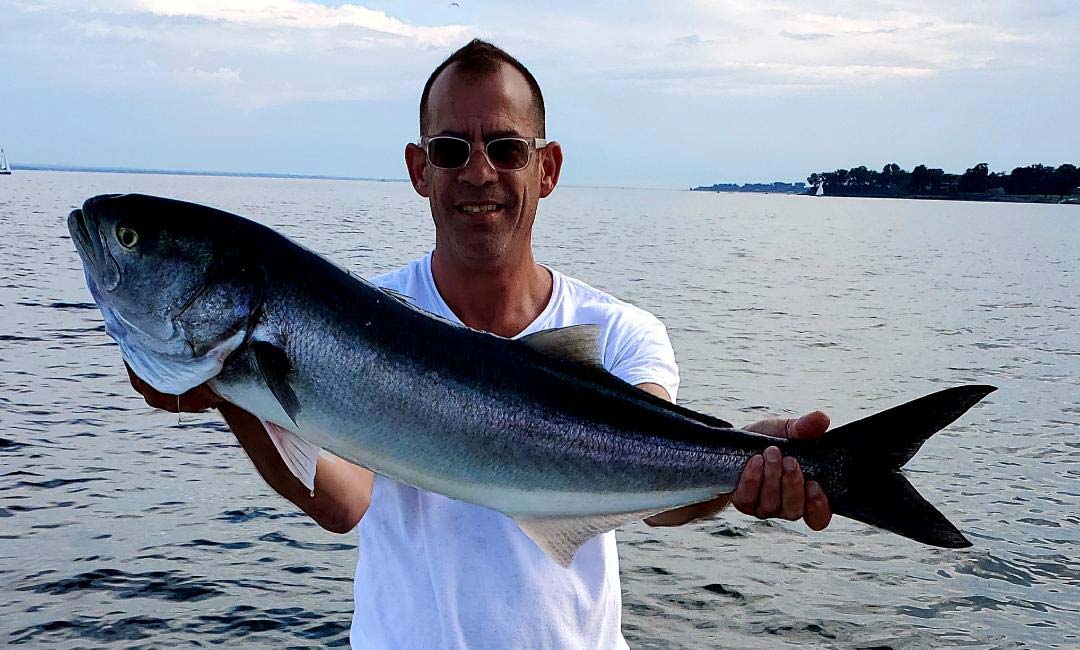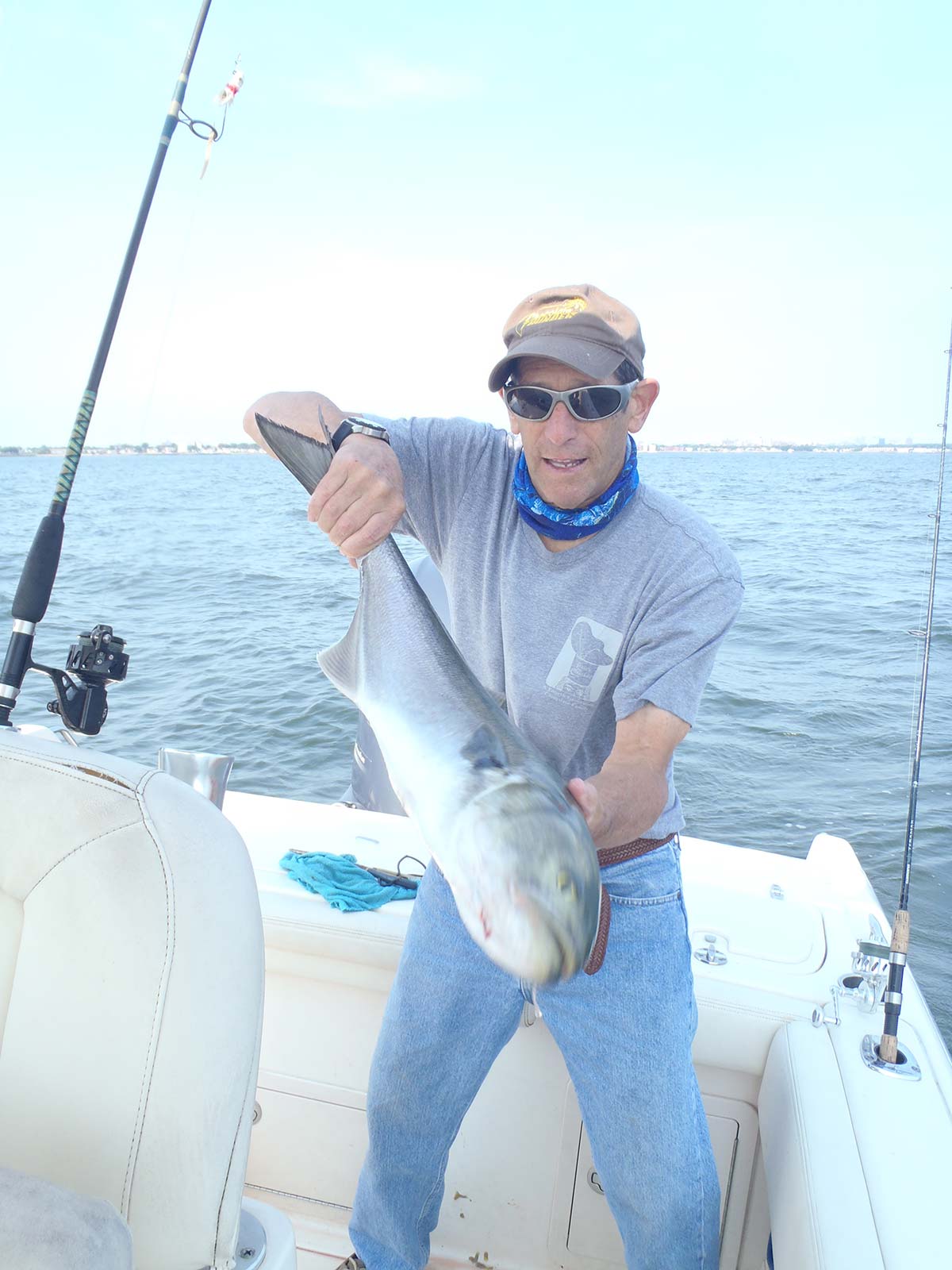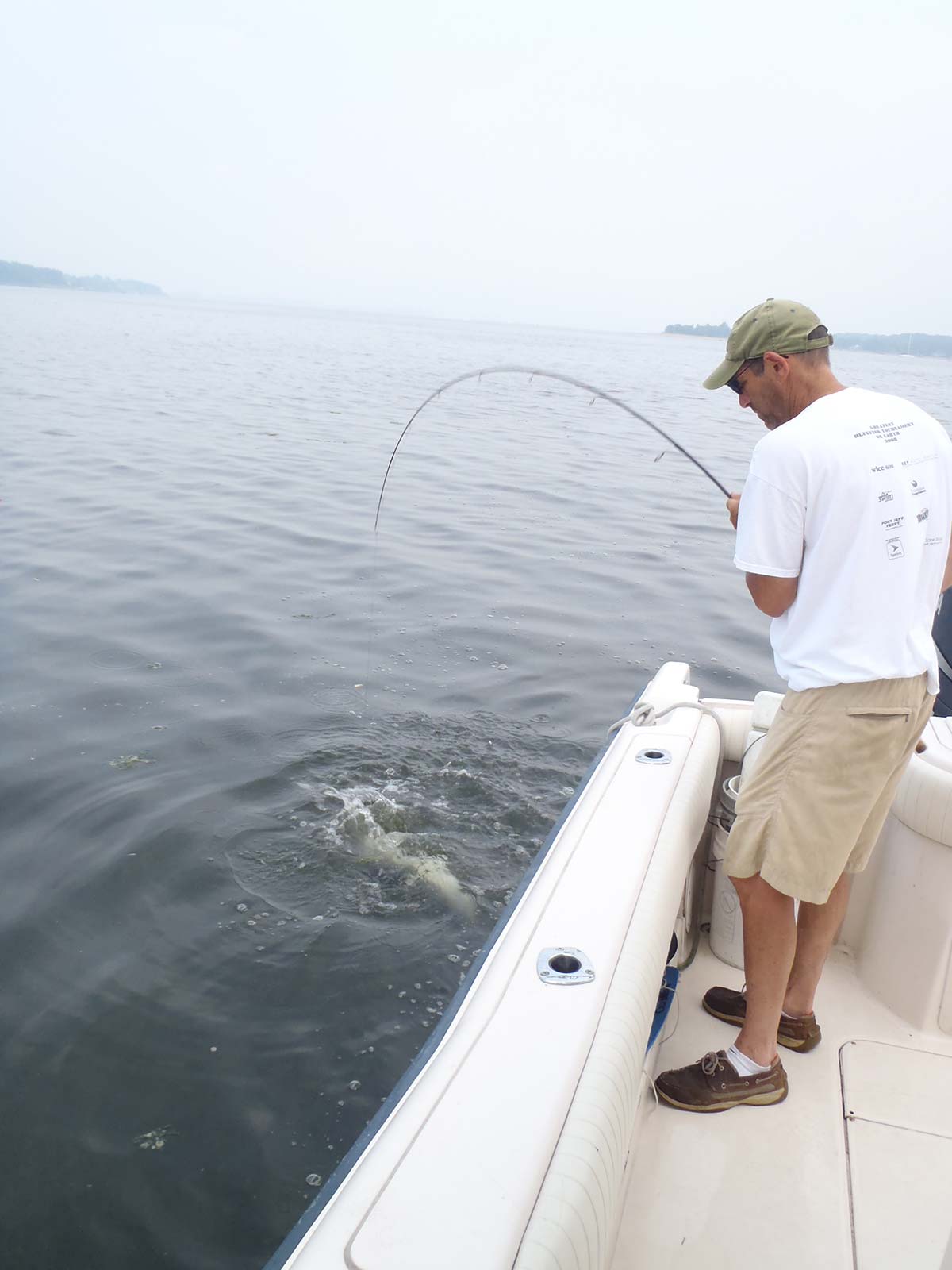
When all else fails, look to the flats to score with blues.
What was once routine fishing for bluefish slowly ebbed away in the second decade of the 21st Century as the population crashed. Many of us remember decades of spring, summer, and fall fishing for blues that often weighed 20 pounds or more. Back then, Rich Lazar and I pursued these monsters assiduously; especially on calm late summer days when a glassy surface allowed us to spot the tips of tail fins, as big blues lazily daisy-chained on the surface.
It was a special treat indeed to watch a cluster of big choppers follow a pencil popper as it worked across a calm surface in clear water and then, with fish darting left and right, watch a single fish decide to attack, and the fight was on. Although the visual show on surface lures was “worth the price of admission,” the fish swarmed and attacked subsurface lures, too. These battles on effective light tackle were epic, but when we looked around, we saw no other boats. We wondered, “Where is everybody?” and asking, “How can anyone not like this?” The answer; some anglers aren’t as eager to catch big blues as others are, and when asked why, they’d say, “Not interested, I’m bluefished out!” Nonsense, how does a true angler become bored with teen-size blues on light tackle?

Love Lost!
Eventually, there were no runs in the harbors, or in the Sound, for that matter, save for a few North Fork beaches. The decline of the bluefish was one of the reasons that Rich and I became such avid porgy fishermen. We substituted numbers for size, and ultra-light tackle for light tackle, and found ways to amuse ourselves with competition games, various challenges of gear, methods, and locations. For example, Rich likes to start each trip with a game. If an angler catches seven porgies before the other angler catches one, Rich calls this a shutout. Although that makes sense to me as a game, he also says that eight-to-one is a shutout. This makes no sense to me, but okay, it’s fun. Over the years, Rich has extended the game to all the species we catch. It’s a good point of focus and provides lots of laughs. Although each summer we lament the demise of the light tackle blue-fishing, we eventually settled on the reality that we’d never see the likes of giant blues in the harbors and Sound flats again, and we turned our sites on other things.
Nature’s Dirty Little Tricks
Never underestimate nature’s ability to throw curve balls into the seasonal mix of fishing opportunities. For example, a phone call from Darren Kaye—one of Rich’s local fishing buddies— about big blues. Now, Darren fishes hard and often does so from near dawn to well after sunset. He covers a lot of water and sees a lot of fishing, so if anyone would find an unexpected school of big blues, it would be Darren. He reported that a huge school of large blues was feeding on local flats in Long Island Sound in 5 to 8 feet of water.
For those not familiar with the extreme western Sound, it features repeating boulder strewn points that are much closer together than those found further east. Between the points are flats of sand that often attract bait schools in summer and early fall. Of course, any significant buildup of bait attracts predators. So, although the points produce tidal rips that produce serious action on stripers, blues, and weakfish, the bites usually die out as the currents at the points subside. Then, the fish spread out looking for bait schools that were carried through the rips and away from the points by the tide. Much of the bait seeks shelter on the shallow flats between the points. It’s an evolved ploy to avoid predators, but it doesn’t work because predators have evolved too, and aren’t shy about following the bait toward shore. So, at low tide it’s the flats that produce best.

Sadly
Although I was eager to get into Darren’s blues, weather issues and personal responsibilities shot-circuited our plans. I was only able to make one trip, but what a trip it was. As Rich eased his boat onto the flats, I worried that the trip would be a bust since I saw no bait, no tail tips, no birds, no swirls, or anything else that might have indicated the presence of a school of blues crushing small peanut bunker.
“Don’t worry,” Rich said, “it’s been this way every time, just make a cast and you’ll see.” I opted for a bucktail and pork rind and Rich threw a pencil popper. We often use different lures when we start, as a way to quickly understand what the fish prefer on any given day. I was still questioning the possibility of a big day with heavy-duty blues when something bumped my bucktail but missed. I turned my head to the sound of a blue crashing Rich’s pencil popper and suddenly my rod bent over, too. By God, I thought, this is happening! We both landed 8 and 10-pound bluefish—not the monsters of previous decades, but big enough to be reminiscent of the “old days.” Eventually we caught blues up to 12 pounds; an even better reminder of past glory.
Every drift produced fish, but only in the 5-to-8-foot depth zone. We drifted into deeper water as we fought and released fish, and before making a run onto the flats, we cast where we were just to be sure all the fish were shallow. This is a sound tactic since fish do swim and free-swimming fish often follow hooked fish to the boat. It’s worth a cast or two. Clearly, the fish were on the flats. Okay, rev the motor and get back to the flats. Amazingly, we looked around and were the only boat targeting the blues: just like the “old days.” Yes, they were a handful of other boats in the area, and chunking in the deeper areas off the flats. They caught nothing.
You Think They’ll Hit This?
It wasn’t long before we began expanding the envelope. That is, “I wonder if they’ll hit this lure?” They did! The action was non-stop and, since bluefish are non-stop fighting machines, it wasn’t long before I sat on my butt to recoup some energy. Rich looked at me and I said, “I’m no spring chicken, you know.” He laughed, but it wasn’t long before he also took a break. As I sat there waiting to catch my breath, I reflected on a time, no more than a few decades ago, when I’d fish for these monsters all day in boats and in the surf, and not fatigue until the last few fish. Still, that was then, and this is now. So, I said to self, take a few deep breaths and get back to work: Do you ever give yourself a pep talk?
It wasn’t long before there were only three short hairs still attached to my bucktail head. They hit it anyway, but continuing to use a hairless bucktail just didn’t seem right. I felt as if I was disrespecting these silver-sided fighting machines, so I changed to a new bucktail which was also quickly reduced to a lead head with a dangling little red thread where the flanged hair used to be. Tins worked great—everything worked, although I did not use any lures with treble hooks; I left that job to Rich who enjoys surface commotions much more that I do. I stay clear of trebled lures for several reasons. First, it’s much safer for me. Second, it’s much safer for the bluefish. Third, I lose fewer fish. Fourth, I get the fish off the hook faster and thus I’m casting again while Rich wrestles with pliers and hooks. Wait a minute! Maybe taking more time unhooking fish is a good idea—a little rest can’t be a bad thing at my age.

Tackle
Exactly what do I mean by “effective light tackle.” This is not wimpy tackle, rather capable rod and reel combinations that make sense but aren’t “meat tackle.” I use a 7-foot Shimano Teramar rod with medium power and a fast action tip. The fast action tip allows me to make long accurate casts and the medium power allows me to fight large fish effectively without exhausting them. That way, when released, the fish have an excellent chance for long-term survival. My reel is a Van Staal 150. Better quality modern reels stand up to saltwater, have gear designs that provide excellent power, and are very durable when used under pressure. I spool the reel with 20-pound braid (either Sufix Performance Braid or Daiwa J-Braid). I tie a Spro 50-pound swivel to the braid, and an 18-inch length of 30-pound Perlon leader material to the other loop of the swivel. The Spro swivel is very small but every bit of 50-pound test. Because it’s small it doesn’t make bubbles and is less visible under water. That’s a plus with bluefish because, similar to most pelagic fishes, they have much better eyesight than striped bass. As a result, they often attack the swivel and bite through the line as they are attracted to both the size of the swivel and the bubbles in its wake. The final piece to the leader is a paper clip style snap at the end of the Perlon. I use either Spro or Tactical Angler clips.
Handle With Care
| HANDLE WITH CARE |
| With respect and conservation in mind, take your time releasing big blues—especially in the summer when water temperatures are above 70 degrees. Again, blues are pelagic fish, and pelagic fish have a much narrower temperature tolerance than inshore species. They fight hard, build up more metabolic wastes faster, and thus require more time to revive or they’ll die within three days. In a boat there are several ways to help blues towards a better release. One, if you have any kind of fish gripper, use it to hold the fish upright in the water until it struggles to get away. Second, you can place the blue in a net and hold it overboard until the fish is able to regain its vigor. Third, you can hold the blue by its tail until it revives. Scientists tell us not to push the fish back and forth because it actually can drown them. Always push forward instead. |
Although few anglers I talk to about the decline of bluefish want to hear it, it’s true nonetheless. The population is crashing due to the same old reasons: overharvesting and poor recruitment. If you balk at this, simply go to the ASMFC website and see for yourself. The numbers you’ll see are scary and real. As sportsmen, that reality should challenge us to be more responsible stewards of this precious living resource. Harvesting a fish or two for your family to eat is great, but killing as many as you legally can and wasting them by forgetting them in the freezer or distributing them to friends, relatives, and neighbors just isn’t compatible with the current state of the bluefish population. What most serious anglers ultimately come to realize is that the fun of catching is much more important than killing them. It’s a natural evolution of an angler: predator to conservation-based sportsman.
I sure hope 2021’s flats encounter wasn’t simply a one-off event. I choose to be hopeful and so I wait with anticipation for 2022 battles with big blues on light tackle.





